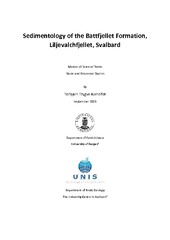| dc.description | A regressive megasequence of Eocene age consisting of the offshore Frysjaodden Formation, the shallow-marine Battfjellet Formation, and the continental Aspelintoppen Formation (together constituting the “GBA-unit”) represents the last of three depositional cycles filling in the Central Basin on Spitsbergen, Svalbard. This foreland basin developed in front the West Spitsbergen Fold and Thrust Belt (WSFTB) during the breakup between Svalbard and Greenland. The Battfjellet Formation has been subject to extensive research, especially on the shelf edge deltas and clinothems in the western and central parts of the basin. This study however, investigates the facies distribution and sandbody geometry of the lesser-documented Battfjellet Formation shelf deltas in the eastern part of the basin, in an area of approximately 5km2 at Liljevalchfjellet, Svalbard. Analysis of facies and facies associations revealed a wide range of depositional environments from offshore to continental. The internal structure of these regressive successions suggests a highly wave-dominated deltaic setting. However, due to a significant presence of carbonaceous detritus, distributary fluvial channels incising shallow marine deposits and previous studies documenting a complex delta lobe stacking pattern, a fluvio-wave interaction delta is suggested for the Battfjellet Formation. A combination of high subsidence and sedimentation rate lead to rapid progradation of the delta lobes into a wave-agitated basin, while transgressive reworking of interdistributary bay/lagoons took place simultaneously between the delta lobes. A total of six stacked parasequences with an overall regressive low angle ascending shoreline trajectory was identified by combining work from Olsen (2012) with this study. Paleocurrent measurements points to a southeastward-directed outbuilding of the system, different to the generally interpreted eastwards outbuilding for the GBA-Unit. Thus, a shift towards a more southward directed progradation likely took place in the later stages of basin infill. To better view the sandbody geometries and facies distributions, a 3D conceptual reservoir model focusing on the Battfjellet Formation is presented. | |
